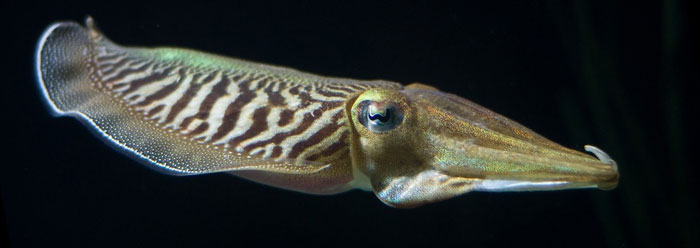Cuttlefish are mollusks that look somewhat like squid. They have an internal, hard, supportive structure with soft organs around and inside it. This resilient "cuttlebone" is made of cleverly woven strands of a biochemical material called chitin and mixed with a hard biomineral called aragonite.
A team of paleontologists found a supposedly 34 million-year-old fossil cuttlebone that still had both the original aragonite and chitin. This is significant, because one might expect the hard aragonite to persist in the fossil record, but not the organic chitin or protein. The chitin, which is made of sugars tightly bonded into molecular chains, would have spontaneously degraded and been long gone after only thousands of years.
The researchers compared the fossil cuttlebone, found in a Mississippi clay deposit, with modern cuttlebone chitin, and their results showed a "shortening of the chitin strands,…the breakdown of chitosan [chemically altered chitin],… and loss of hydrogen bonds."1 Thus, the chitin has been falling apart, as would be expected based on chitin biochemistry.
But the fact that it has not yet completely decayed is only expected if the cuttlebone was fossilized just thousands of years ago. If this fossil cuttlebone was deposited during Noah's Flood, then its partly decayed chitin fits well with the Bible's chronology.
The researchers also used three separate techniques to test for "original endogenous organics," all of which confirmed the presence of chitin. They wrote in the online journal PLoS ONE that their results "show preservation of degraded original organics consistent with β-chitin."1
Original chitin has rarely been reported in fossils. But it's unclear if that is because it is not actually present, or because it is not expected to be there—and as a result is hardly ever even investigated.
The same goes for radioactive carbon-14. Few scientists have investigated its presence in the fossil record. Like chitin or protein, all the carbon-14 in organic material should have been eliminated after only thousands of years of spontaneous decay. However, it is abundant in coal, oil, and fossils throughout the geologic column.2, 3
Another reason the cuttlebone chitin was unexpected is that chitin-eating bacteria degrade it in a matter of days in aquatic ecosystems.4, 5 But even if chitin is kept sterile, it spontaneously decays, just like other biomolecules such as DNA and proteins.
Despite the belief that fossils represent millions of years, the rigorous tests performed by these PloS ONE authors verified that this cuttlebone contained original endogenous chitin. And that means that it, and very possibly all the fossils found near it, are not as old as evolutionary history says they are.
References
- Weaver, P. G. et al. 2011. Characterization of Organics Consistent with β-Chitin Preserved in the Late Eocene Cuttlefish Mississaepia mississippiensis. PLoS ONE. 6 (11): e28195.
- Baumgardner, J. 2003. Carbon Dating Undercuts Evolution's Long Ages. Acts & Facts. 32 (10).
- Giem, P. 2001. Carbon-14 Content of Fossil Carbon. Origins. 51: 6-30.
- Boyer, J. N. 1994. Aerobic and Anaerobic Degradation and Mineralization of 14C-Chitin by Water Column and Sediment Inocula of the York River Estuary, Virginia. Applied and Environmental Microbiology. 60 (1): 174-179.
- Stankiewicz, B. A. et al. 1998. Biodegradation of the chitin-protein complex in crustacean cuticle. Organic Geochemistry. 28 (1-2): 67-76.
* Mr. Thomas is Science Writer at the Institute for Creation Research.
Article posted on December 14, 2011.




